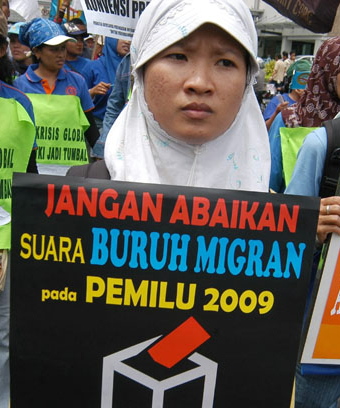Identity and Pleasure: The Politics of Indonesian Screen Culture invites us to embark on a visual journey of difficult episodes in Indonesian history
Fadjar I Thufail
This is not a book about films. It is a book about how films and other forms of popular culture point to the places where interests, positions and desires come together, especially on issues of religious, ethnic and national identity.
The author, Ariel Heryanto, examines the complex and negotiated feelings of belonging to religious, ethnic and class identities in post-Suharto Indonesia. The book presents constructions of social identity and social belonging. These constructions are always transforming, incorporating, rebutting, subverting and balancing each other – to the point that it becomes impossible to talk about identity and identification as anything but heterogeneous and perpetually in flux.
The book takes a close look at the politics of film-making and film screening in Indonesia to demonstrate how cultural production is shaped by religious convictions, ideological struggles, traumatic memories and aspiring desires. Heryanto presents stories about how Indonesians turn to screen culture to help them reconsider what it means to be Muslim, Chinese, or Indonesian.
Heryanto brings a critical reading to a view common among media scholars that cultural products such as films are used to impart messages. He also interrogates the ‘cultural industry’ school’s claim that a cultural product possesses an aura, and the continuous reproduction and mass distribution of the product will distort the aura so the material no longer reflects what the original creator has intended. He shifts our attention from representation to production and suggests we investigate the ways in which the act of production enables or limits debates around politics, or allows exchanges of ideas between creators and critics.

The author dislodges the notion of ‘popular’ from its ideological baggage and situates it at the dynamic intersection of ideological and emotional politics. He argues that it is no longer possible to separate popular culture from high-culture. Regardless of class, producers and consumers share or contest their desires, visions of society and political aspirations within the same space. As such, the book offers a fresh and original perspective on the study of Indonesian screen culture; a critical alternative to structural or formal approaches that have dominated media studies until now.
The book shows how screen culture has become a site for Indonesians to debate religious politics, reflect on violent pasts, challenge state sovereignty, and question ethnic and gender identity. Fiction and documentary films in particular are sites where negotiations of identities, values, norms and visions of society take place and evolve.
Heryanto carefully reveals how various narratives, symbols, and production strategies are appropriated and applied by stakeholders in the media industry to navigate contentious religious and ethnic identities, historical justice, and modern sensibilities in post-New Order Indonesia.
Identity and Pleasure builds on an argument Heryanto proposed in his previous work, relating to the ways in which state politics has intervened to shape social identity. The New Order regime coerced Indonesians into accepting that ethnic identity and social class are categories guarded by moral righteousness, making them unchanging, timeless and ‘sacred’. In this realm, which Heryanto calls ‘fatally belonging’, identity is fixed and mixing or moving between identities is disallowed. In this earlier work, he describes elaborate techniques deployed by the state to erase and pacify attempts to introduce differing views in the public sphere. Identity and Pleasure adds to this, demonstrating that whilst the state has tried hard to maintain this effort, there are spaces within the public realm where the power of the state is continuously questioned and challenged. The production of screen culture (live action and documentary films) is one of those sites.
Narratives and symbolism are important elements of screen culture, and films display or discard certain narratives and symbols in order to make statements. For example, Heryanto describes how a certain recurring view of Islamic thinking, entangled with anti-Communist and anti-Chinese sentiments, has expanded in Indonesia and influenced fiction and documentary films and society’s reaction to them. A closer look at the statements being made about Islam in these films reveals a more complicated narrative. The generic Islamic discourse disappears, revealing instead a range of ideological threads from Salafism to post-Islamism, and making it impossible to categorise films or the statements they make as simply ‘Islamic’.
A similar situation can be observed in the production of films dealing with human rights and social justice. Deciphering the symbols and narratives present in these films is a complex and unstable practice, despite the claim that the films promote universal values. Heryanto discusses Joshua Oppenheimer’s films The Act of Killing and The Look of Silence as examples of narratives and symbols around the 1965 massacre being presented differently from other films. The Look of Silence steers away from categories that place perpetrators and victims in neat boxes. In doing so, even though it is contains the same symbolic materials as other films on 1965, the film reveals an unstable relationship between contradictory discourses, shedding a new light on this violent past, which even today many Indonesians have been unable to come to terms with.
Indonesians resort to films to question, and at the same time secure their positions in the ‘fatally belonging’ categories. Sometimes these efforts come together neatly but other times they unravel, with people finding their positions mixed and overlapping amongst those categories . It is a matter of politics, so to speak. Heryanto successfully demonstrates that screen culture is a site where post-New Order Indonesians question what various identities mean to them and share, consume and interrogate their moral and political convictions, all while enjoying their leisure time.
Ariel Heryanto, Identity and Pleasure: The Politics of Indonesian Screen Culture, Singapore, National University of Singapore Press, 2014.
Fadjar I Thufail (fadjarthufail@gmail.com) is from the Research Center for Regional Resources, Indonesian Institute of Sciences.















